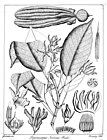Note: This is a project under development. The articles on this wiki are just being initiated and broadly incomplete. You can Help creating new pages.
Dipterocarpus turbinatus - Asvakarna
Asvakarna, is a deciduous tree, usually growing 35 - 50 metres tall, but with reports of specimens up to 60 metres. The straight, cylindrical bole can be up to 150cm in diameter and free of branches for two thirds of the tree's height. The tree is harvested from the wild mainly for the oleo-resin in its trunk. This is used locally and also exported. The tree also yields a timber of low quality, though this is used on a large scale in the manufacture of plywood.
Uses
Parts Used
Chemical Composition
Common names
| Language | Common name |
|---|---|
| Kannada | challaane, kalpaini, googe, valivara |
| Hindi | garjan, teli-garjan, tihya-garjan |
| Malayalam | |
| Tamil | challani, enney, enneymaram, karalam, karccamaram, vellenney, yennar |
| Telugu | |
| Marathi | NA |
| Gujarathi | NA |
| Punjabi | NA |
| Kashmiri | NA |
| Sanskrit | ajakarna, asvakarna |
| English |
Properties
Reference: Dravya - Substance, Rasa - Taste, Guna - Qualities, Veerya - Potency, Vipaka - Post-digesion effect, Karma - Pharmacological activity, Prabhava - Therepeutics.
Dravya
Rasa
Tikta (Bitter), Katu (Pungent)
Guna
Laghu (Light), Snigdha (Oily)
Veerya
Ushna (Hot)
Vipaka
Katu (Pungent)
Karma
Kapha, Vata
Prabhava
Habit
Identification
Leaf
| Kind | Shape | Feature |
|---|---|---|
| Simple | alternate | 7-25 x 4-17.5 cm, ovate, apex acute or acuminate, base acute, obtuse or cordate, margin crenate, undulate, glabrous, coriaceous; lateral nerves 10-15 pairs, parallel, prominent, intercostae scalariform, obscure; petiole 17-50 mm, slender, glabrous, swollen tipped; stipules large, lateral, leaving an annular stipular scar, tomentose. |
Flower
| Type | Size | Color and composition | Stamen | More information |
|---|---|---|---|---|
| Bisexual | axillary spiciform racemes | White-pink | 30 | fragrant, 3-5 together in axillary racemes; pedicels 3 cm long. Calyx cupular at base, lobes 5, unequal. Petals 5, tinged with pink. Stamens 30; filaments yellowish, often dilated at base; connective aristate. Ovary superior, slightly adherent to the calyx tube, 3-celled, ovules 2 in each cell. |
Fruit
| Type | Size | Mass | Appearance | Seeds | More information |
|---|---|---|---|---|---|
| Nut | 10 x 2 cm | wings 2, oblong, reddish-brown | {{{6}}} |
Other features
List of Ayurvedic medicine in which the herb is used
Where to get the saplings
Mode of Propagation
How to plant/cultivate
Season to grow
Soil type
Propagation
Commonly seen growing in areas
Photo Gallery
References
External Links
- Ayurvedic Herbs known to be helpful to treat Skin disorders
- Ayurvedic Herbs known to be helpful to treat Urinary tract disorders
- Ayurvedic Herbs known to be helpful to treat Ulcers, wounds
- Ayurvedic Herbs known to be helpful to treat fever
- Ayurvedic Herbs known to be helpful to treat Worm infestation
- Ayurvedic Herbs known to be helpful to treat Ear disorders
- Herbs with Oil used in medicine
- Herbs with Bark used in medicine
- Herbs with Leaves used in medicine
- Herbs with common name in Kannada
- Herbs with common name in Hindi
- Herbs with common name in Tamil
- Herbs with common name in Sanskrit
- Habit - Tree
- Index of Plants which can be propagated by Seeds
- Herbs that are commonly seen in the region of Tropical area
- Herbs
- Plants of western ghats
- Dipterocarpaceae


